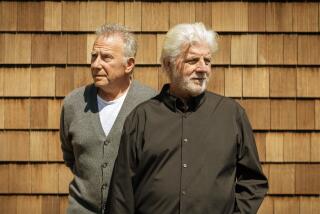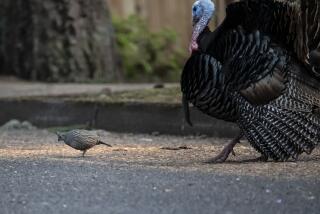Review: Helen Macdonald’s ‘H Is for Hawk’ swoops into the wild
- Share via
When her beloved father died in London, Helen Macdonald slipped past grief into a melancholic depression, and as a poet, naturalist and close observer of nature and words, she identified what she felt and what she intuitively needed.
In this singular book that combines memoir and landscape, history and falconry, Macdonald robs from her anger by choosing to train and live with a robber bird, and in doing so, she becomes wild. A wild animal. A veteran falconer, she chose this time to inhabit the world with a goshawk, “spooky, pale-eyed psychopaths that lived and killed in woodland thickets.”
One of the most compelling facets of the memoir is the way the writer, who knows from childhood that she is a “watcher” of other humans and feels more comfortable with nature, weaves in multiple histories: those of Great Britain, of falconers and birds of prey all over the world, and especially, the story of T.H. White. Famous for “The Sword in the Stone,” he also wrote “The Goshawk,” his own memoir, in which a tortured man who suffered a peculiarly English childhood of beatings and disdain recounts his inept and finally cruel attempts to train a goshawk.
Macdonald read the book as a child and was appalled; she, whose twin brother died shortly after their birth, who feels loss and displacement throughout her childhood, rereads the book as an adult with a goshawk named Mabel.
Her absolute eloquence with descriptions of the birds and landscapes and the thrill of the natural world makes the memoir compelling. Here is Mabel on first meeting, emerging from a box on a dock in Scotland, where Macdonald had gone to buy her: “The hawk’s wings, barred and beating, the sharp fingers of her dark-tipped primaries cutting the air…She is a conjuring trick. A reptile…Something bright and distant, like gold falling through water. A broken marionette of wings, legs and light-splashed feathers.”
To take a wild animal inside a living room, onto a perch, and make it not fear you, but trust you, is a grueling and all-consuming process, and yet sometimes it’s comical how little Macdonald cares about the rest of the world, or convention. Her refrigerator is stocked with “hawk food and frozen pizza.”
Realize that hawk food proffered during training consists of dead animals. With Mabel, Macdonald fights death with death. She and the bird fight, misunderstand each other, and Macdonald despairs of ever being able to fly her hawk free. One veteran falconer says to her, “It’s simple. If you want a well-behaved goshawk, you just have to do one thing. Give ‘em the opportunity to kill things. Kill as much as possible. Murder sorts them out.’”
This memoir is not about passages of grief, or ways of coping; it is not like anything I’ve ever read about a daughter who loses a father. Macdonald breaks the necks of wild rabbits so that her hawk does not eat them alive. She skins baby chicks to offer them to her bird. She describes death again and again as Mabel takes down prey — tearing of skin, puddle of feathers, and blood everywhere.
“Notice what it notices. The hawk’s apprehension becomes your own…Such a feat of imaginative recreation has always come easily to me. Too easily. It’s part of being a watcher…I had put myself in the hawk’s wild mind to tame her, and as the days passed in the darkened room my humanity was burning away.”
Falconry has its own vocabulary (to rouse is to shake all the feathers and settle, meaning the hawk is content), equipment (jesses and creances) and obsessions. The reader feels obsessed as well, waiting for Mabel to become used to her human, to stop hurling herself away from anything that frightens her, and to become trained enough to fly outside on a long lead, and finally, to fly free. Then, the reader worries along with Macdonald every time the goshawk soars off the glove after prey. Because the ultimate irony of falconry is that the human spends the greater part of life with a wild bird, creating a bond based on trust, and then lets that bird into the widest of landscapes: the open sky. Over and over, Macdonald recounts stories of birds that flew away.
But Macdonald and Mabel’s bond proves strong. We watch them ramble, and Macdonald muses on walking, ecology, chalk terrain and English traditions.
At the pulsing heart of the book, though, is the swift and heartless moment of death, and the ever-present open vistas of sky and freedom, the daily gamble of life with a raptor. “Every night I slept and dreamed of creances, of lines and knots, of skeins of wool, skeins of geese flying south. And every afternoon I walked out onto the pitch with relief, because when the hawk was on my fist I knew who I was, and I was never angry with her, even if I wanted to sink to my knees and weep every time she tried to fly away.”
In Southern California, I raise chickens. I have a Mexican fighting hen who is 14 years old, and this spring, I can’t let her out of her enclosure because for the third year, redtail hawks are nesting in the sycamore tree across the street. The recent infestation of squirrels means my neighborhood has five hawks right now, wheeling and crying overhead. The day this book arrived in the mail, I stood in my laundry room and heard through the window a huge rush of displaced air. It was the largest female redtail, who swooped through my backyard and landed on the telephone wire only 15 feet off the ground. Regal, feral, oblivious to me, she transformed my yard into wild heartbeats.
That is what Macdonald tells us so eloquently in her fine memoir — that transformation of our docile or resigned lives can be had if we only look up into the world.
Straight, author of eight novels, is finishing a new one set on Prince Edward Island.
H Is for Hawk
Helen Macdonald
Grove: 300 pp., $26
More to Read
Sign up for our Book Club newsletter
Get the latest news, events and more from the Los Angeles Times Book Club, and help us get L.A. reading and talking.
You may occasionally receive promotional content from the Los Angeles Times.









